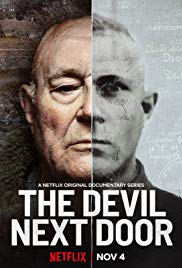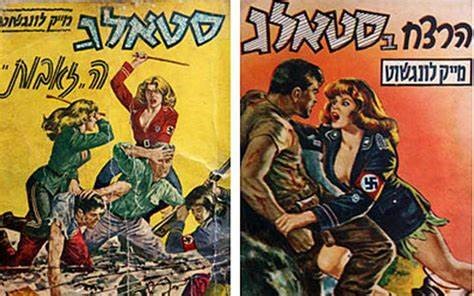First They Came for John Demjanjuk . . .
Posted By Morris van de Camp On In North American New Right | Comments DisabledThe Devil Next Door [2] (2019)
Directed by Yossi Bloch & Daniel Sivan
. . . but I wasn’t a Ukrainian accused of being a Nazi prison guard, so I did not speak out. In the 1980s, John Demjanjuk (1920–2012) was a retired auto worker living near Cleveland, Ohio who was accused of having been an exceptionally cruel SS prison guard called “Ivan the Terrible” by prison inmates at the Treblinka death camp in Poland. As a result, throughout the last decades of his life he was subjected to several agonizing show trials, among other legal problems. Recently, a Netflix documentary called The Devil Next Door (2019) has been released which tells his story – and it’s quite good. After seeing it, I’ve come to conclude that John Demjanjuk’s story is important, and indeed sheds a great deal of light on other matters: Namely, the American Deep State’s relationship with the organized Jewish community.
The Demjanjuk case summarized
To understand John Demjanjuk, one needs to understand Ukrainian culture and history during the period when it was a Soviet Socialist Republic during the Cold War. Ukraine comprises two cultural parts. In the west, the people have been marked by Western Europe; they generally grow up Roman Catholic, although there is a small but active Protestant community, and the people take their secular cultural cues from Berlin and Warsaw. In the east, the people speak Russian rather than Ukrainian, follow the Eastern Orthodox faith, and take their secular cultural guidance from St. Petersburg and Moscow.
 [3]
[3]The results of the 2004 Ukrainian Presidential Election, showing the split between the more culturally Ukrainian community in the west and the Russians in the east. This pattern is consistent over time. Demjanjuk was from western Ukraine.
Ukraine suffered terribly under Communist rule, and there were two separate famines in the decades between 1920 and 1940. The second famine was called the Holodomor, and the starvation was a deliberate Soviet effort to mass murder Ukrainians. (The famine probably fell harder on western Ukrainians than others, but this is speculation.) When the Germans invaded the Soviet Union during Second World War, Demjanjuk was drafted into the Soviet army and was captured along with thousands of others in the Crimea. Demjanjuk later insisted that he had remained a prisoner until the end of the war, although it is very possible that he served in the German armed forces in some capacity later. At the conclusion of hostilities, Demjanjuk bounced around several displaced persons camps and claimed he was Polish rather than Ukrainian to avoid being repatriated to the USSR. He emigrated to the United States in the early 1950s and worked as a machinist at the Ford plant in Cleveland. In Ohio, Demjanjuk didn’t engage in politics and was a model citizen. Throughout his trial, his colleagues at the Ford plant, his neighbors, and those in his church never wavered in their support for him.
In 1975, a pro-Communist newspaper [4] in the United States accused Demjanjuk of being one of a large number of former Nazis living secretly in America. The KGB had sent the paper an identity card that appeared to show that Demjanjuk was a member of the Waffen-SS. The KGB likely targeted Demjanjuk after they discovered that he was financially supporting his mother in Ukraine. Due to Ukraine’s complex cultural ecosystem and tragic history, the Soviet authorities were highly suspicious of émigrés. Enter the US Justice Department’s Office of Special Investigations (OSI). The purpose of this office is to find former Nazis in hiding and put them on trial for Holocaust-related crimes. The documentary obfuscates this office’s nature, so to clarify: It was established in 1979 through the efforts of the Jewish Congresswoman Elizabeth Holtzman and staffed with top-notch lawyers and investigators, many of whom were Jews, although its figurehead leader was a non-Jew, Walter Rockler. One such Jew is the OSI’s current Director, Eli Rosenbaum, who has worked for the organization for various periods since 1980 and who features prominently in the film. Something that is not mentioned in the documentary but easily discoverable through an Internet search is that the OSI has accused a number of people of being Nazis, but has often either lost the cases or won only to later discover that they were incorrect. For his part, Rosenbaum got the rocket scientist Arthur Rudolf deported, despite the fact that Rudolf’s efforts in developing the Saturn V and Pershing rockets played no small part in winning the Cold War.
The OSI went after Demjanjuk with a ferocious glee. In a just world, the courts would have declared the documents inadmissible and the case would have ended there. After all, the only bit of physical evidence at all was an identification document whose chain of custody originated in the Soviet KGB. Additionally, the Soviet Union was known to be hostile to western Ukrainians, and the release of Demjanjuk’s card was probably designed to divide anti-Soviet Ukrainians from anti-Soviet Jews. There was plenty of evidence to show that it was a forgery. I would not be surprised if there was behind-the-scenes Jewish pressure on the judges to rule against Demjanjuk despite the dubiousness of the evidence. There was also a snobbish and highly active group of anti-anti-Communists in the United States during the Cold War that carried out rather sophisticated pro-Soviet metapolitical activity, and this probably also helped to prevent an outright dismissal of the evidence.
Rosenbaum and his cronies at the OSI used the courts to first strip Demjanjuk of his American citizenship, and after more legal wrangling, Demjanjuk was deported to Israel to stand trial. His defense team consisted of a young attorney named Mark J. O’Connor and Yoram Sheftel, a flamboyant Israeli Jew. The documentary implies that O’Connor didn’t do the best job, and he was fired by Demjanjuk towards the end, but he stayed on the case regardless. However, it is clear that O’Connor was a lion in the courtroom. He destroyed the credibility of the prosecution’s two star witnesses. One witness, Eliyahu Rosenberg, had reported personally killing “Ivan the Terrible” in depositions made decades earlier. However, “Ivan the Terrible” had somehow been resurrected and Rosenberg “affirmed” that Demjanjuk was “Ivan the Terrible” through a melodramatic and preposterous “looking in his eyes” courtroom moment. Rosenberg had been a “working Jew” at Treblinka. Working Jews cut hair, cleared bodies, and so on. Another witness claimed he had taken a train from Israel to Florida to testify at a different Holocaust trial. Indeed, until that moment, the outlandish and contradictory claims of Holocaust survivors had never been questioned.[1] [5] Regardless, there was no possible outcome for Demjanjuk other than a guilty verdict in an Israeli court.
After the Soviet Union fell apart, more documents became available that showed that Demjanjuk was not “Ivan the Terrible,” and the Israeli Supreme Court released him. It was also later shown that the OSI had hidden exculpatory evidence. Demjanjuk’s citizenship was restored. However, Rosenbaum went after Demjanjuk yet again, and the OSI’s story shifted. Instead of being “Ivan the Terrible” at Treblinka, they now said, Demjanjuk had been a guard at Sobibor, a different death camp. Strangely, the courts didn’t shut down the OSI’s second case even though the earlier case had been a public debacle and obviously a vindictive Jewish shell game. Demjanjuk was again stripped of his citizenship and this time sent to Germany. He was found guilty of being a Nazi and was then released to a nursing home, since by then he was a very old man. Since he died before his appeal was adjudicated, his conviction was vacated. He is buried in Ohio in an unmarked grave.
Stalags and other matters
There are some strange elements in the “Ivan the Terrible” story that need illumination. The first thing that jumps out about the survivor’s testimonies is their sexual and pornographic sense. For example, “Ivan the Terrible” was accused of using a sword to cut off the breasts of Jewish women before gassing them. One must wonder it this is possible at all. I find it unlikely that the Germans issued swords to foreign enlisted men. I can only speculate that the testimonies of Demjanjuk’s accusers were influenced by Stalag fiction.
Stalag fiction was a popular form of pornography in Israel during the 1950s and early 1960s, until the Israeli government banned them. They typically centered on a concentration camp prisoner being forced to service Nazis sexually, and often ended with the protagonist raping and murdering the Nazi. It was in this form that sexual sadism mixed with the Holocaust story, and probably influenced the memories of actual Holocaust survivors.
One must also look at the numbers. The US Holocaust Memorial Museum’s high estimate for murders at Treblinka is 925,000 Jews. Treblinka operated from 23 July 1942 until 19 October 1943, a total of 453 days. To achieve 925,000 murders during that time, Jews had to be killed at a rate of one every seven-tenths of a minute. This means that the entire system – gathering Jews from elsewhere in Europe, putting them on a train, transporting them, getting them off the train at Treblinka, gassing them, and then quickly disposing of the bodies so the next batch wouldn’t see what’s coming would have been an operation requiring smooth operations all along the line. If a group of Jews got an inkling of what was happening there would have been the risk of a spontaneous uprising. Thus, a low-ranking Ukrainian soldier causing a panic by amputating the breasts of the women waiting in line would have gummed up the works considerably; hence it seems unlikely that it could have happened.
There was in fact a revolt at Treblinka on August 2, 1943, which was put down. So why didn’t the SS simply murder the “working Jews” – who, it should be said, colluded in the Holocaust every bit as much as the non-Jewish camp staff – afterwards? Eliyahu Rosenberg claimed he had killed “Ivan the Terrible” during the uprising. From a Nazi perspective, he was completely disposable; so why wasn’t he simply shot and replaced? Why didn’t the Nazi leadership send the Ukrainian draftees (such as Demjanjuk was accused of being) on some sort of hopeless suicide mission in the manner of Uriah the Hittite after dismantling Treblinka to further hide the evidence of their crimes? None of this was ever addressed.
Then they came for a colorful Ohio Congressman . . .
. . . and I didn’t speak out because I wasn’t a colorful Ohio Congressman. Demjanjuk was supported at high levels by two people. The first was Pat Buchanan, then a Reagan White House staffer. The second was Congressman James Traficant. The latter was a great public speaker, always on top of his game, and he supported Demjanjuk to the end. Although he was a Congressman, he was not able to stop the machinations of the OSI. And strangely, none of those Justice Department investigators who hid exculpatory evidence in the first Demjanjuk case were disbarred. Instead, they got a free pass to simply change their story and try again.
This is where the film got me revisiting an observation I made when I reviewed the 2018 Waco mini-series [8]. I noticed that ethnonationalist Jews supported the US Justice Department’s FBI throughout the Waco debacle even to the point of obviously lying on film about the Branch Davidians “pouring gas” on their compound as part of a non-existent “suicide pact” during the FBI’s disastrous final assault. I think a possible reason for this is that the US Justice Department is the mailed fist of the Deep State, and the purpose of this Deep State is to support the interests of the organized Jewish community. Obviously, not every person in the US Justice Department is Jewish, and minor Jewish aims are not always achieved through the Justice Department’s operations – but in a larger sense, the hypothesis holds true.
It is probable that by having an OSI with a free hand to go after obscure and aging “Nazis” in the late 1980s, the organized Jewish community got a large cadre of ethnonationalist Jews into the Justice Department. Once there, they could make professional connections, build networks, and shape who gets promoted and who doesn’t. When the FBI screwed the pooch, so to speak, at Ruby Ridge, Waco, the Richard Jewell case, and the utterly incompetent anthrax investigation, Jewish activists continued to support this organization, as it was an asset to them.
This asset has paid off. Consider that in 2002, during the run-up to the Jewish-planned Iraq War, the US Justice Department carried out two high-profile hit jobs that helped nip any effective anti-war and counter-Semitic resistance in the bud. The first attack was against white advocate David Duke, who had a solid electoral record up to that point, and the other was Congressman Traficant. Both were felled by dubious claims of financial improprieties. Indeed, not only did the Congressman Traficant support Demjanjuk, but he was a prominent critic of American support for Israel. From the perspective of the Israel lobby and the organized Jewish community, they had a potent – albeit somewhat isolated – enemy in Traficant, and it was cheaper to use taxpayer funds to railroad an Israel-skeptic Congressman than replace him through an expensive campaign requiring private donations, such as was the case with Paul Findley (R–Illinois).
To put it another way, it is plausible that the US Justice Department – or at least many people therein – can, to a degree, be seen as conspirators in a pre-packaged coup ready to remove anyone perceived as hostile to Jewish interests. Throughout the “Russia hacking” hoax, for example, there was one Justice Department Jew after another making all sorts of accusations. Indeed, General Michael Flynn was a prominent critic of America’s pro-Israel foreign policy, and he was likewise felled by the Justice department for “obstruction of Justice.” The organized Jewish community probably sees the Justice Department as some sort of insurance policy in case the Yankees in America get tired of their swindles.
 [9]
[9]The Connecticut Western Reserve is the northeast section of Ohio. Its founders were Connecticut Yankees. Demjanjuk’s family were not out of place in this area, and never lost the support of the local community.
Yankees and Jews
I’ve noticed that whenever there is a Jew-Gentile conflict in the United States, there is often a Yankee vs. Jew situation in play, and this has been true since Ulysses S. Grant[2] [10] ordered all Jews to be evacuated from his military district in 1862. This also applies in the in the Demjanjuk case. Of course, Demjanjuk’s ancestors weren’t on the Mayflower or Arbella [11], he was most certainly not a Unitarian Universalist or Congregationalist, and he’d probably never heard of Cotton Mather. However, put his son and son-in-law (both shown in the film) in a blue Union Army uniform and they wouldn’t look out of place in Mr. Lincoln’s Army.
Cleveland is in the Western Reserve, a portion of northeastern Ohio that was given over to the State of Connecticut after independence and settled by people from that New England state. One book on the region states:
Descendants of the Puritan Mathers share the Reserve with the Slovenian Lausches, only recently removed from the mountains of Yugoslavia. The campus of Western Reserve University, with its strong New England tradition, has for its neighbor the Cleveland Cultural Gardens wherein nineteen nationality group pay respect to their unique cultures with formal gardens and statues honoring the great in music, literate, history and drama.[3] [12]
In other words, the Demjanjuk family fit into a community whose founders traced their roots to New England in general and Connecticut in particular, and that community is comfortable with the many western – dare I say Germanophile – Slavs who also live there.
What to do?
When looking at the pattern of oppression by the US Justice Department, starting with John Demjanjuk and ending most recently with General Flynn, I can only feel a sense of helplessness. The US Justice Department isn’t going anywhere, and its leadership is probably very cautious about preventing pro-whites from entering its ranks and marching through the institutions. However, such a strategy is very likely the best thing to follow on our way to the white ethnostate. Meanwhile, awareness of injustice is always helpful in the short term. Indeed, I can only shout into the wind: “John Demjanjuk, I wish I’d said something, for I fear that when they come for me (and you, and you, and you), no one will be left to speak out.”
Notes
[1] [13] Since the Demjanjuk case, many Holocaust frauds have been uncovered, such as Herman Rosenblat [14], Joseph Hirt [15], and Enric Marco [16].
[2] [17] Indeed, Grant was an Ohio man with Connecticut Yankee ancestors.
[3] [18] Harlan Hatcher, The Western Reserve: The Story of New Connecticut in Ohio (Cleveland/New York: The World Publishing Company, 1966), pp. 4 & 5.


